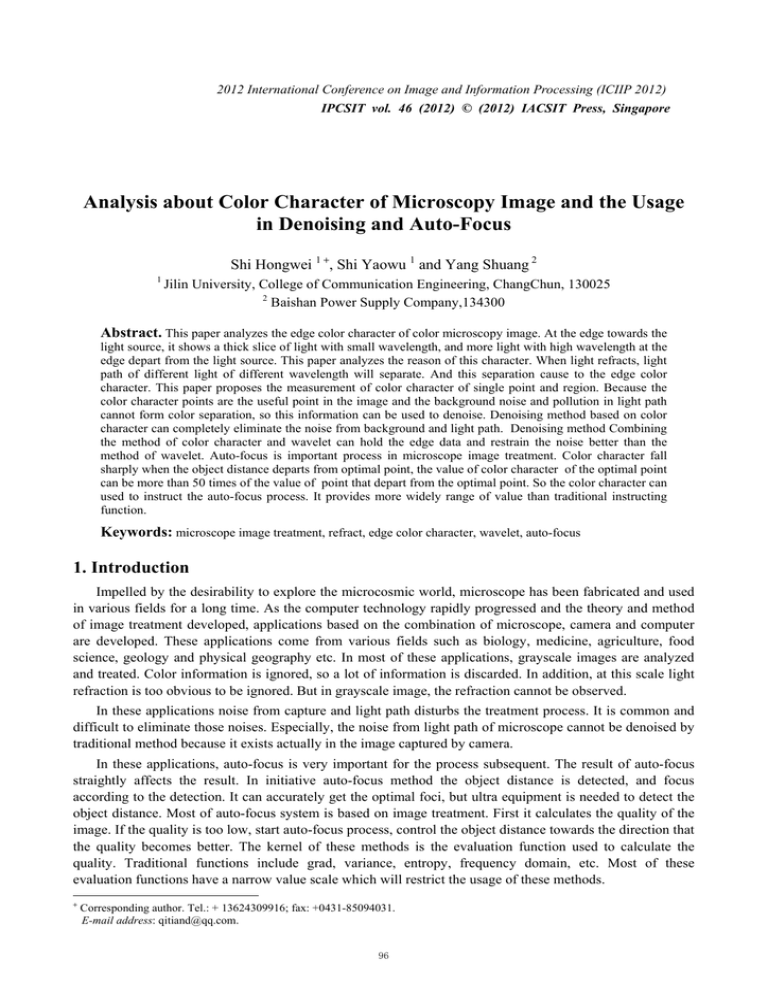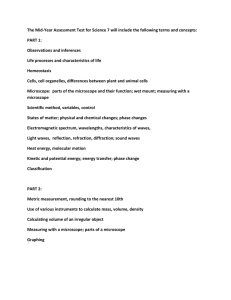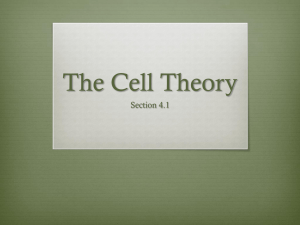Analysis about Color Character of Microscopy Image and the Usage
advertisement

2012 International Conference on Image and Information Processing (ICIIP 2012)
IPCSIT vol. 46 (2012) © (2012) IACSIT Press, Singapore
Analysis about Color Character of Microscopy Image and the Usage
in Denoising and Auto-Focus
Shi Hongwei 1 +, Shi Yaowu 1 and Yang Shuang 2
1
Jilin University, College of Communication Engineering, ChangChun, 130025
2
Baishan Power Supply Company,134300
Abstract. This paper analyzes the edge color character of color microscopy image. At the edge towards the
light source, it shows a thick slice of light with small wavelength, and more light with high wavelength at the
edge depart from the light source. This paper analyzes the reason of this character. When light refracts, light
path of different light of different wavelength will separate. And this separation cause to the edge color
character. This paper proposes the measurement of color character of single point and region. Because the
color character points are the useful point in the image and the background noise and pollution in light path
cannot form color separation, so this information can be used to denoise. Denoising method based on color
character can completely eliminate the noise from background and light path. Denoising method Combining
the method of color character and wavelet can hold the edge data and restrain the noise better than the
method of wavelet. Auto-focus is important process in microscope image treatment. Color character fall
sharply when the object distance departs from optimal point, the value of color character of the optimal point
can be more than 50 times of the value of point that depart from the optimal point. So the color character can
used to instruct the auto-focus process. It provides more widely range of value than traditional instructing
function.
Keywords: microscope image treatment, refract, edge color character, wavelet, auto-focus
1. Introduction
Impelled by the desirability to explore the microcosmic world, microscope has been fabricated and used
in various fields for a long time. As the computer technology rapidly progressed and the theory and method
of image treatment developed, applications based on the combination of microscope, camera and computer
are developed. These applications come from various fields such as biology, medicine, agriculture, food
science, geology and physical geography etc. In most of these applications, grayscale images are analyzed
and treated. Color information is ignored, so a lot of information is discarded. In addition, at this scale light
refraction is too obvious to be ignored. But in grayscale image, the refraction cannot be observed.
In these applications noise from capture and light path disturbs the treatment process. It is common and
difficult to eliminate those noises. Especially, the noise from light path of microscope cannot be denoised by
traditional method because it exists actually in the image captured by camera.
In these applications, auto-focus is very important for the process subsequent. The result of auto-focus
straightly affects the result. In initiative auto-focus method the object distance is detected, and focus
according to the detection. It can accurately get the optimal foci, but ultra equipment is needed to detect the
object distance. Most of auto-focus system is based on image treatment. First it calculates the quality of the
image. If the quality is too low, start auto-focus process, control the object distance towards the direction that
the quality becomes better. The kernel of these methods is the evaluation function used to calculate the
quality. Traditional functions include grad, variance, entropy, frequency domain, etc. Most of these
evaluation functions have a narrow value scale which will restrict the usage of these methods.
+
Corresponding author. Tel.: + 13624309916; fax: +0431-85094031.
E-mail address: qitiand@qq.com.
96
2. Analysis of Color Character of Microscopy Image
Because the slide has different transmissivity to light with different wavelength, the compositions of the
light that arrives at the field-lens is not the same as the light that the light resource emit. For example, the
microscope we use has a yellow light source, but the image we get have a thicker red color than green color.
At the margin of bacteria and other material on the slide, it show more red color on the edge that is depart
from the light source and more green color on the edge that is toward to the light source. The sample is
shown in figure 1. To explorer the reason, we will analyze the light path of microscope image.
Fig. 1: Edge color character of microscopy image
2.1. Supposal about dot light source
The actual light source of microscope is not dot light source. The light emitted from light source is
focused by condensing lens before it arrives at field-lens. So we can suppose that the light is emitted from
the focus of the condensing lens.
2.2. Analysis about the edge of the material on the slide
The material on the slide holds the light through it and form dark region in the image. But at the different
edge of the material it show different color character. At the direction toward the light source, there is a slice
of green region. And at the direction depart from the light source, there a slice of red region. To analyze this
phenomenon, we analyze the affection of refraction.
Figure 2 show the light path with refraction existing.
Fig. 2: Refraction affect the observe result
From Figure 2, we know that when the light penetrates the slide, it is refracted. Observer will see the
light comes from the image light source position that is closer to the slide. The larger refractive index, the
higher position of image light source. So when we observe the same material on the slide from a same
direction, the green image comes from a higher position than red image. Figure 3 shows image position of
green image and red image.
As shown in Figure3, at the edge toward the light source, there is a slice of region that red light is
blocked while green light can however arrive at. So the image we get shows a slice of green region at the
edge toward the light source. At the edge depart from the light source, there is a slice that red light can arrive
at while green light is blocked. So the image we get shows a slice of red region at the edge depart from light
source.
97
If the material is small, the green region and the red region would be too closely that the actual edge of
the material is faint. In this instance we can estimate the edge with this information to guarantee the nicety of
edge estimation. The edge position is the important and useful points in the image. So we can separate the
image to several regions, if there is no color points in any region, there should be no useful information in
that region. When object distance departs from optimal point, the color points will be fast faint, so it can be
used to auto-focus.
Fig. 3: Green and red image with refraction exis
3. Measurement of Color Character
When we get the color image from camera fixed on the ocular of the microscope, we can define the color
ratio of single point as equation 1:
⎧r
⎪⎪ g (r > g )
d= ⎨
⎪ g (r ≤ g )
⎪⎩ r
(1)
Where d is the measurement, r is the red value and g is the green value. So we see d is a value not
smaller than 1. In image with scale of 0 to 255, if r or g is 0, set it to 1.
For a region, the measurement can be defined in three forms:
Average value:
D=
∑
d (i, j )
(2)
n
Where n is the total points count in this region.
Maximum value:
Dmax = max(d (i, j ))
(3)
High average value:
Dh =
∑ d (i, j )
nh
{d (i, j ) > D}
(4)
nh is the points count where d (i, j ) > D .
These three formulas can show the measurement of color character of a region. Equation 2 is serious
influenced by background points. Equation 3 may be influenced by capture noise. Equation 4 is more stable
and has a large scale. So equation 4 is more useful in practical works.
4. Use Color Character To Denoise
98
As we have analyzed, noise from background and light path is harmful in practical work and disturb the
treatment subsequent. Especially, noise from light path cannot be eliminated by traditional method because
they are actual content in the image. The sample of light path noise is shown in fig 4.
Fig. 4: Sample of light path noise
As show in the figure, region we draw a frame round has useful content. Out of the frame we can see two
blocks of light path noise. There isn’t color character within these noises. So we can identify and eliminate
these noises by the measurement of color character.
First we separate the image to several parts, measure the color character of every part, if the value is
larger than a threshold, remain the region, else, clean it.
The denoising result of fig 4 is shown in fig 5, we use 1.6 as the threshold.
Fig. 5: Denoising result of fig 4
As shown in fig 5, all useful information is remained, and all regions without useful information are
eliminated.
In traditional denoising method, edge protecting and noise eliminating is a pair of conflict, if we want
better denoising result, the edge will be blurred, and if we want to protect the edge, more noise will remain in
the image. As we know now, the color character can find the useful position in the image, so it can work
with wavelet or other filter to denoise. In the regions which contain useful information, we try to protect the
edge, while in the regions without useful information, we can enhance the denoising degree.
5. Use color character in auto-focus process
In the detecting applications with microscope, it is common that the region to be detected cannot be
observed in one single visual field. So the slide needs to move so that all regions to be detected can be
observed. When moving, because to the precision of mechanism precision, it is common that the object
99
distance depart from the useful foci, and the image become too fuzzy to identify the aims. Then auto-focus
system is necessary.
In some auto-focus method s, object distance is measure initiative. But most auto-focus method are
based on image quality. In these methods, the clarity of the image is calculated. When object distance
changes, the guideline function shows extremun (maximum or minimum) at the point that the image is most
clear.
Auto-focus technology is mature in digital camera, some methods for the auto-focus of microscope have
been developed. These methods mostly use the same quality measurement function as digital camera. But
some characters of microscope make it difficult to apply these methods to be used successfully in auto-focus
system of microscope. First in the auto-focus process of microscope, it maybe come to a point that the object
distance is apart away from optimal point seriously so that the we can see nothing in the visual field.
Secondly the refraction and diffraction is visual in this scale, they can make some additional edge
information (high frequency information) that disturb some quality functions.
Most of traditional quality functions provide a narrow value scale, the maximum is less than 2 times of
minimum. That is impeditive to searching process in auto-focus process.
When object distance departs from optimal point, the color character of the whole image will obviously
fall. The value of the measurement around in optimal point is shown in fig 6.
Fig. 6: measurement of the whole image around the optimal object distance
The peak point is the optimal point of the object distance. At this point the image is clearest and the color
character is most obvious. When object distance departs this point in either direction, the value falls sharply.
The maximum of the maximum value is 50 times of the low value. That is larger than any traditional quality
measurement method. This value is irrespective to refraction and diffraction, so it can accurately denote the
optimal point.
The value just changes in a small object distance range, so we should use other quality function in widely
searching process, and when it is closed to the optimal point, the color character is be useful to find the
optimal point. When we find a single point with obvious color character, we can label a region around this
point, and just calculate the value of this region in following searching.
6. Conclusions
This paper shows the edge color character of color microscope image, and analyzes the reason of this
phenomenon. It points out that this character is due to the different refractive index of light with different
wavelength. At the edge towards the light source, there is an area with color of smaller wavelength (higher
frequency), and color of larger wavelength ( low frequency) at the edge depart from the light source.
This character can be used to denoise and auto-focus. When used to denoise, it can point out the useful
information points and can absolutely eliminate the noise from light path. It also can work with other
denoising methods such as wavelet and filters.
This character can be used in auto-focus process, around the optimal object distance, it changes sharply,
the maximum can up to 50 times of smaller value. It is favorable when searching for optimal point.
100
7. References
[1] Yong-guang Yin, Yun Ding. A close to real-time prediction method of totalcoliform bacteria in foods based on
image identification technology and artificial neuralnetwork, Food Research International, 2009, 42(1), pp 191–199
[2] Pan Weizhen Study on the Location of the Spot Light Source's Visual Image Below the Parallel Plate Glass.
Journal of Shaoxing College of Arts and Sciences(Natural Science) 2001-3, pp 64-66 ,
[3] Yao Jinli,Wang Xia. Microscope Image Deno ising A lgorithm Study and Realization Based onW avelet T
ransform. Computer and Digital Engineering. Vol 36 No 7, pp.21-26
[4] Zhou Yan, Cao Wen. An Improvement of Noise Removal Arithmetic to the Color Microscopic Image.
Microcomputer Information. Vol 23 No 4-3 p.287-294
[5] YI Qiu - shi,ZHANG Hong - min,WU Ping Design and implementation of optical auto - focus
microscopy .Computer Engineer ing and Applications. Computer Engineering and Applications. vol 2007-43
pp.119-215
[6] HU Tao, CHEN Sh-i zhe, LIU Guo- dong, PU Zhao-bang. Selection of Auto-focus Function in Micro Visual
System. SEMICONDUCTOR OPTOELECTRONICS vol 27 No2, pp 216-220
[7] Huang Yihe, A method for image denoising based on new wavelet thresholding function. Transducer and
Microsystem Technologies. Vol 30 No 9. p.76-81
101



